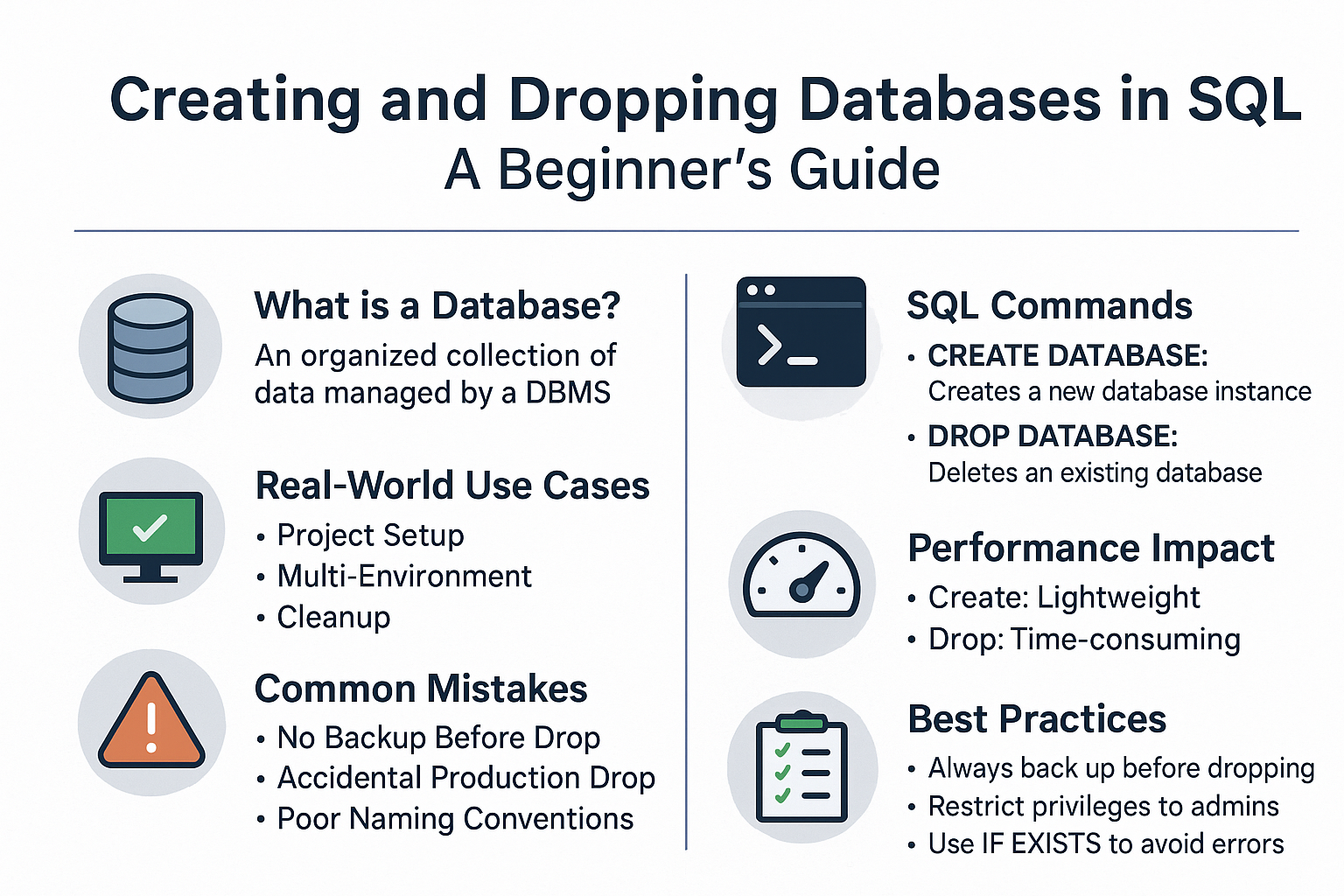Introduction
Creating and dropping databases are foundational tasks for managing relational database systems. These operations allow you to set up new environments for applications or remove unused resources to keep your server clean.
Why This Matters
- Create Database: Initializes a structured container for data storage.
- Drop Database: Removes an entire database, freeing up resources.
Real-world analogy:
Creating a database is like constructing a new warehouse for storing goods. Dropping a database is equivalent to demolishing that warehouse when it's no longer needed, making space for something new.
Core Concepts
What is a Database?
A database is an organized collection of data managed by a Database Management System (DBMS). It contains schemas, tables, indexes, and other objects necessary for data storage and retrieval.
SQL Commands
- CREATE DATABASE: Creates a new database instance.
- DROP DATABASE: Deletes an existing database and all associated objects.
SQL Examples
Creating a Database (PostgreSQL/MySQL)
CREATE DATABASE ecommerce;
Creating a Database with Owner (PostgreSQL)
CREATE DATABASE ecommerce OWNER admin_user;
Dropping a Database
DROP DATABASE ecommerce;
Safe Dropping with IF EXISTS (PostgreSQL/MySQL)
DROP DATABASE IF EXISTS ecommerce;
Real-World Use Cases
- Project Setup: Creating databases for new web applications.
- Multi-Environment: Maintaining separate dev, test, and prod databases.
- Cleanup: Dropping unused databases to save disk space and server resources.
Common Mistakes and Anti-Patterns
- No Backup Before Drop: Leads to irreversible data loss.
- Accidental Production Drop: Always verify environment before execution.
- Poor Naming Conventions: Causes confusion when managing multiple databases.
Performance and Scalability Implications
- Create: Lightweight operation, negligible performance impact.
- Drop: Can be time-consuming for large databases with many objects.
- Multi-Tenant Systems: Too many databases can strain server resources; consider using schemas.
RDBMS Comparison
| Feature | PostgreSQL | MySQL | Oracle |
|---|---|---|---|
| Create Command | CREATE DATABASE |
CREATE DATABASE |
CREATE DATABASE / CREATE USER + SCHEMA |
| Drop Command | DROP DATABASE |
DROP DATABASE |
DROP DATABASE via SQL*Plus |
| Ownership | Set via OWNER | Managed via privileges | Managed via tablespaces |
| Safety Options | IF EXISTS supported |
IF EXISTS supported |
Requires manual validation |
Best Practices & Optimization Tips
- Back up before dropping any database.
- Use meaningful, descriptive names for databases.
- Restrict CREATE/DROP privileges to administrators.
- Use
IF EXISTSto avoid errors during automated scripts.
When to Use vs When to Avoid
Use CREATE DATABASE When:
- Starting new projects or environments.
- Segregating data logically for security or organization.
Avoid DROP DATABASE When:
- No verified backup exists.
- The database is actively in use by production systems.
Conclusion & Key Takeaways
Creating and dropping databases are essential DBA operations. With proper planning, safety checks, and best practices, you can manage your environments efficiently and securely.
Key Points:
CREATE DATABASEinitializes a new database environment.DROP DATABASEpermanently removes a database and its contents.- Always back up and verify environments before dropping.
FAQ
1. How do I create a database in SQL?
Use CREATE DATABASE db_name;.
2. How do I drop a database?
Use DROP DATABASE db_name;.
3. Can I recover a dropped database?
Only via backups; DROP is irreversible.
4. What permissions are needed?
Admin or superuser privileges are usually required.
5. Can I rename a database instead of dropping it?
PostgreSQL: ALTER DATABASE old_name RENAME TO new_name;.
6. Is there a way to avoid errors if DB doesn’t exist?
Use DROP DATABASE IF EXISTS db_name;.
7. Should I create separate databases for every app?
Depends on architecture; sometimes separate schemas suffice.
8. Does dropping a database free disk space?
Yes, once the database files are removed.
9. How to list databases?
PostgreSQL: \l in psql, MySQL: SHOW DATABASES;.
10. What’s the difference between a database and a schema?
A schema is a namespace inside a database; a database is the container for schemas.
